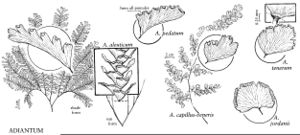Difference between revisions of "Adiantum jordanii"
Bot. Zeitung 1864: 26. 1864.
FNA>Volume Importer |
FNA>Volume Importer |
||
| Line 24: | Line 24: | ||
|elevation=0–1000 m | |elevation=0–1000 m | ||
|distribution=Calif.;Oreg.;Mexico in Baja California. | |distribution=Calif.;Oreg.;Mexico in Baja California. | ||
| − | |discussion=<p>Adiantum jordanii occasionally hybridizes with A. aleuticum where their ranges overlap in northern California, yielding the sterile hybrid Adiantum × tracyi C. C. Hall ex W. H. Wagner. Adiantum × tracyi, morphologically intermediate between its parental species, can be distinguished from A. jordanii by its broadly deltate leaf blade that tapers abruptly from the 4(–5)-pinnate base to a 1-pinnate apex. It is best separated from A. aleuticum by leaf blades with a strong rachis, and by ultimate blade segments that are less than twice as long as broad. Adiantum × tracyi shows 59 univalents at metaphase; its spores are irregular and misshapen (W. H. Wagner Jr. 1962).</p> | + | |discussion=<p><i>Adiantum jordanii</i> occasionally hybridizes with <i>A. aleuticum</i> where their ranges overlap in northern California, yielding the sterile hybrid <i>Adiantum</i> × tracyi C. C. Hall ex W. H. Wagner. <i>Adiantum</i> × tracyi, morphologically intermediate between its parental species, can be distinguished from <i>A. jordanii</i> by its broadly deltate leaf blade that tapers abruptly from the 4(–5)-pinnate base to a 1-pinnate apex. It is best separated from <i>A. aleuticum</i> by leaf blades with a strong rachis, and by ultimate blade segments that are less than twice as long as broad. <i>Adiantum</i> × tracyi shows 59 univalents at metaphase; its spores are irregular and misshapen (W. H. Wagner Jr. 1962).</p> |
|tables= | |tables= | ||
|references= | |references= | ||
| Line 48: | Line 48: | ||
|publication year=1864 | |publication year=1864 | ||
|special status= | |special status= | ||
| − | |source xml=https://jpend@bitbucket.org/aafc-mbb/fna-data-curation.git/src/ | + | |source xml=https://jpend@bitbucket.org/aafc-mbb/fna-data-curation.git/src/8f726806613d60c220dc4493de13607dd3150896/coarse_grained_fna_xml/V2/V2_522.xml |
|genus=Adiantum | |genus=Adiantum | ||
|species=Adiantum jordanii | |species=Adiantum jordanii | ||
Revision as of 15:48, 18 September 2019
Stems short-creeping; scales reddish brown, concolored, margins entire. Leaves arching or pendent, clustered, 30–45 cm. Petiole 1–1.5 mm diam., glabrous, not glaucous. Blade lanceolate, pinnate, 20–24 × 8–10 cm, gradually reduced distally, glabrous; proximal pinnae 3(–4)-pinnate; rachis straight, glabrous, not glaucous. Segment stalks 1–4 mm, with dark color ending abruptly at segment base. Ultimate segments fan-shaped, not quite as long as broad; base truncate or broadly cuneate; margins of fertile segments unlobed but very narrowly incised, sterile segments with margins lobed, denticulate; apex rounded. Indusia transversely oblong, 3–10 mm, glabrous. Spores mostly 40–50 µm diam. 2n = 60.
Phenology: Sporulating early spring–midsummer.
Habitat: Seasonally moist, shaded, rocky banks, canyons, and ravines
Elevation: 0–1000 m
Distribution

Calif., Oreg., Mexico in Baja California.
Discussion
Adiantum jordanii occasionally hybridizes with A. aleuticum where their ranges overlap in northern California, yielding the sterile hybrid Adiantum × tracyi C. C. Hall ex W. H. Wagner. Adiantum × tracyi, morphologically intermediate between its parental species, can be distinguished from A. jordanii by its broadly deltate leaf blade that tapers abruptly from the 4(–5)-pinnate base to a 1-pinnate apex. It is best separated from A. aleuticum by leaf blades with a strong rachis, and by ultimate blade segments that are less than twice as long as broad. Adiantum × tracyi shows 59 univalents at metaphase; its spores are irregular and misshapen (W. H. Wagner Jr. 1962).
Selected References
None.
